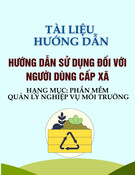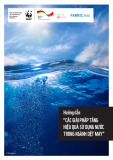
ISSN 1859-1531 - THE UNIVERSITY OF DANANG - JOURNAL OF SCIENCE AND TECHNOLOGY, VOL. 22, NO. 11B, 2024 85
INFLUENCE OF RAINFALL AND SOIL-WATER CHARACTERISTIC CURVE
ON SLOPE STABILITY FOR UNSATURATED SOIL:
CASE STUDY AT ROUTE 14G, DANANG, VIETNAM
Le Manh Thuong, Dinh Minh Tran*, Tran Trung Viet
The University of Danang - University of Science and Technology, Vietnam
*Corresponding author: tdminh@dut.udn.vn
(Received: September 06, 2024; Revised: October 02, 2024; Accepted: October 05, 2024)
DOI: 10.31130/ud-jst.2024.525E
Abstract - This study utilizes Geo-Slope 2D to evaluate slope
stability along Route 14G, integrating soil characteristics and
historical rainfall data to analyze the slope stability based on the
Factor of Safety (FoS). Key findings highlight the significant
role of Soil-Water Characteristic Curves (SWCCs) and
permeability coefficients in determining slope responses to
varying rainfall levels. Soils with higher permeability
coefficients, like clayey soil 3, exhibit more rapid decreases in
FoS, leading to earlier instability. The result identified a critical
rainfall threshold associated with slope failure, highlighting that
instability can occur before the soil is fully saturated,
challenging conventional assumptions. These insights underline
the importance of considering soil suction and shear strength in
slope stability assessments. The findings provide essential
references for developing effective landslide mitigation
strategies tailored to the specific vulnerabilities of the region,
thereby enhancing the safety and resilience of slopes along
Route 14G.
Key words - Factor of Safety; rainfall; slope stability; Soil-Water
Characteristic Curves; unsaturated soil.
1. Introduction
Landslides on earthen slopes following prolonged
rainfall due to climate change have become increasingly
severe [1]. This phenomenon becomes particularly serious
in areas with earthen slopes as the soil structure is weak
and prone to landslides [2]. Each time there is prolonged
rainfall, the accumulated water on the earthen slope can
increase suddenly, making slopes unstable and susceptible
to landslides [3]. The consequences of landslides on
earthen slopes include loss of life and property and impacts
on local communities' economy and infrastructure [4].
With the growing complexity of climate change, extreme
weather events like prolonged heavy rainfall are expected
to become increasingly severe and dangerous [5].
Consequently, it is crucial to examine, analyze, and assess
the stability of earthen slopes to ensure the safety and
stability of the community.
One of the reasons leading to serious consequences of
landslides after rain is that in assessing slope stability, the
impact of rainfall on the area is often not
comprehensively considered. Previous studies have
focused on factors such as slope steepness, soils, and
geological structures, ignoring the influence of rainfall
[6-8]. However, rain can have many negative effects on
terrain stability. Heavy rainfall can exert strong pressure
on the ground, making it unstable and increasing the
ability of water to seep into the soil, resulting in it being
softer and more susceptible to landslides [9]. In addition,
rain can increase the water load on inclined surfaces,
creating push and pull on the ground, leading to
movement and landslides [10].
In the analysis of slope stability under the influence of
rainfall, current studies are utilizing the soil-water
characteristic curve (SWCC) model proposed by
Fredlund and Xing [11], and Genuchten [12] to determine
the distribution of moisture and water pressure within the
earthen slopes. Globally, numerous research endeavors
have demonstrated the flexibility of this model by
adjusting and applying it to diverse geographies and soils.
The results reveal that the appropriate selection of the
SWCC model can significantly impact the Factor of
Safety (FoS) of slopes, especially when considering
factors such as terrain, soil characteristics, and rainfall
[13]. It is well-established that variations in these
fundamental soil properties can trigger substantial
alterations in the soil's capacity to resist shearing forces
directly impacting slope stability [14].
The empirical insights garnered from previous research
underscore compelling trends. Initially, during periods of
low precipitation, it observes a notable augmentation in
soil cohesion and shear strength owing to the elevated
water pressure within the soil matrix. This phenomenon
accentuates the stability of slopes and fortifies their
resistance against potential failure mechanisms [15].
However, as precipitation intensifies, the dynamics shift
with increased water pressure poses a contrasting effect on
soil shear strength. The influx of moisture serves to
undermine the cohesion of the soil, thereby compromising
its ability to withstand shearing forces. Consequently, this
increasing rainfall-induced instability highlights the failure
susceptibility of slopes [16].
This research focuses on analyzing the effect of rainfall
on the stability of unsaturated slopes at Route 14G in Da
Nang. To unravel the complexities underlying this
phenomenon, we have employed a 2D Geo-Slope model,
recognized for its efficacy in simulating geotechnical
scenarios, to examine the stability of slopes. Our
methodological approach applied soil-water characteristic
curves (SWCCs) of three soils derived from earthen slopes
along Route 14G. Furthermore, our investigation extends
beyond static analyses by integrating considerations of
rainfall variability, a crucial factor of slope stability
assessments.

86 Le Manh Thuong, Dinh Minh Tran, Tran Trung Viet
2. Research parameters at Route 14G
2.1. In-site location
The research area along Route 14G, located to the West
of Da Nang City, Vietnam (see Figure 1), urgently requires
in-depth investigation due to its pronounced vulnerability
to geological erosion. This issue has persistently recurred
during the rainy seasons from 2020 to 2022, and its
persistence underscores the need for a focused study.
Figure 1. Landslide phenomenon on Route 14G
The region's susceptibility to erosion is linked to its
geographical and geological characteristics, such as steep
slopes, loose soil, and frequent heavy rainfall. These
factors have led to significant landslides, where large
sections of soil and rock have become dislodged and slid
down, posing a continuous threat to the area. The
landslides have resulted in substantial soil and rock
overflow onto the roadway, severely complicating ongoing
construction efforts. This obstruction not only hinders
progress but also forces workers to allocate additional time
and resources to clear the debris and soil, which in turn
delays the construction schedule and incurs increased costs
due to the need for repeated cleanup and stabilization. In
addition, the loose soil and rock increase the risk of future
landslides, making the area increasingly unstable and
hazardous for construction workers and future road users.
2.2. Physical and mechanical parameters
In recent studies in Vietnam, it has been pointed out that
most of the land in Da Nang is clayey soil [17, 18]. Table 1
summarizes the physical parameters of three clayey clayey
soils along Route 14G. Table 1 provides a comprehensive
comparison of various physical parameters among the three
clayey soils and illustrates that the natural moisture content
of all three soils does not significantly differ, ranging from
25.3% to 26.95%. Similarly, other parameters such as
natural density, dry density, porosity, void ratio, and
saturation degree exhibit similar values across the samples.
However, the saturated permeability coefficient (ksz) of
clayey soil 1 has the smallest value at ksz ~ 2.84×10-6 cm/s,
followed by clayey soil 2 and clayey soil 3 with values of ksz
~ 3.78×10-5 cm/s and ksz ~ 6.24×10-5 cm/s, respectively. The
internal friction angle increases sequentially to 14.6, 20.1,
and 26.7 degrees, while the cohesion of clayey soil 2 is the
lowest with a value of 8.1, followed by clayey soil 3 at 14.5
and clayey soil 1 at 16.9.
Table 1. Physical and mechanical parameters of three clayey soils [17, 18]
Parameter
Symbol
Unit
Clayey soil 1
Clayey soil 2
Clayey soil 3
Moisture content
W
%
26.95
25.30
26.13
Wet density
γ
kN/m3
18.8
18.9
19.2
Dry density
γd
kN/m3
14.8
15.1
15.2
Void ratio
e
-
0.824
0.781
0.770
Porosity
n
%
45.18
43.85
43.50
Saturated degree
S
%
88.3
87.14
91.3
Internal friction angle
độ (o)
14.6
20.1
26.7
Soil cohesion
C
kPa
16.9
8.1
14.5
Permeability coefficient
ksz
cm/s
2.84 x 10-6
3.78 x 10-5
6.24 x 10-5
2.3. SWCC and permeability coefficient
The experimental results of SWCCs for the three clayey
soils are synthesized in Figure 2, providing a comparative
analysis of their soil-water interaction behaviors [17, 18].
These findings reveal notable variations in the SWCCs of
the three clayey soils, despite their apparent similarity in
classification as clayey soils. Specifically, clayey soil 3
exhibits the lowest suction among the soils, indicating a
lower capacity to retain water under unsaturated
conditions. In contrast, clayey soil 1 rapidly progresses to
saturation, absorbing water quickly and reaching a
saturated state faster than the other soils.
This analysis is significant as it underscores the critical
need to understand the variations in SWCC among soils
that may initially appear similar. These differences in soil-
water interaction behavior can be attributed to various
factors. For instance, pore structure plays a pivotal role, as
soils with larger or more interconnected pores may allow
water to move through more easily, influencing suction and
saturation levels. Mineral composition is another crucial
factor, as certain minerals can affect a soil’s ability to retain
or absorb water. Additionally, the history of the soil,
including its formation, weathering processes, and
previous exposure to environmental conditions, can also
impact its SWCC.
In addition to the analysis of SWCC, we examined the
soil permeability coefficients under cohesive suction
conditions, as shown in Figure 3. This aspect of the study
is crucial because it highlights the significant role that
cohesive forces play in influencing the permeability of
soils, particularly in cohesive soil types such as clay.
Cohesive suction, which arises from the attraction between
particles in fine-grained soils, can greatly affect water
moving through the soil matrix. The results reveal distinct
differences in the permeability coefficients among the
three clayey soils. Notably, clayey soil 3 exhibits the
highest permeability coefficient, indicating that this soil
allows water to pass through more readily under the same

ISSN 1859-1531 - THE UNIVERSITY OF DANANG - JOURNAL OF SCIENCE AND TECHNOLOGY, VOL. 22, NO. 11B, 2024 87
cohesive suction. This result suggests that soil 3 has more
open pore sizes or lower soil cohesion, which facilitates
higher permeability. On the other hand, clayey soil 1
demonstrates a significantly lower permeability coefficient
compared to the other two soils when subjected to the same
cohesive suction. This lower permeability may be due to a
denser pore structure or stronger cohesive forces between
particles, which restrict water flow more effectively. These
findings show that even within the same soil classification,
there can be substantial variations in permeability, which
are influenced by cohesive forces.
Figure 2. SWCCs of three clayey soils
Figure 3. Permeability coefficients of three clayey soils
3. Simulation by Geo-slope 2D
In investigation, we utilize the SEEP/W and SLOPE/W
software modules within the GeoStudio 2023 geotechnical
software suite by GEO-SLOPE to address fundamental
problems such as permeability and slope stability
calculations. The SLOPE/W software integrates with the
SEEP/W module to determine the limit equilibrium slip
surface and stability coefficient of slopes using the
effective stress and pore water pressure equilibrium
method. The simulation steps are conducted as shown in
Figure 4.
In the field of geological engineering, ensuring the
stability of slopes is extremely important to prevent
collapses and accidents. To assess slope stability, the
Bishop method, one of the most popular methods in this
field, is commonly used [19]. The Factor of Safety (FoS)
is used to measure the level of safety of slopes. In this
study, FoS is used to evaluate stability. A higher FoS value
means it provides greater safety against collapse and
accident risks. This also implies that slopes are more
resilient under various conditions. According to the
standard TCVN4054-2005 [20], if the value FoS is greater
than 1.25, the slope is considered safe, and there is no
landslide risk.
Figure 4. Steps in simulation by Geo-Slope 2D
4. Results and discussions
4.1. Consideration of safety of earthen slope
Figure 5 shows the result of a simulation assessing the
stability coefficient of the slope at the location of clayey
soil 1 under natural, unsaturated conditions. The simulation
reveals that the slope at this site achieves a Factor of Safety
(FoS) of 1.377, which is generally considered to provide a
reasonable level of safety under dry or near-dry conditions.
This suggests that the slope is stable under typical
conditions, with a sufficient value FoS to prevent failure.
Figure 5. FoS under natural soil conditions
Despite this initial assessment, real-world observations
indicate that this slope at Route 14G frequently
experiences severe instability during the rainy season. This
period is characterized by heavy rainfall, with average
precipitation levels ranging from 120 mm to 400 mm. Such
heavy rain significantly alters the soil's moisture content,
often leading to saturation. This change in conditions is
critical because it affects the soil's internal structure and the
interactions between soil particles, which can dramatically
reduce slope stability.
Creating
Models
Initial conditions:
SWCC, Rainfall
Factor of Safety
FoS
Start

88 Le Manh Thuong, Dinh Minh Tran, Tran Trung Viet
To further understand this instability, we conducted
additional simulations to evaluate the slope's stability
under saturated soil conditions. The results of these
simulations, as shown in Figure 6, show a significant
decrease in the FoS, dropping to 0.873 when the soil is
fully saturated. This value FoS is well below the safe
threshold, indicating a high likelihood of slope failure
under this condition.
Figure 6. FoS under saturated soil conditions
Given this result, it is evident that slope instability at
this location is a significant concern, particularly during the
rainy season. To address this issue, it is crucial to conduct
a more detailed analysis of the impact of rainfall on slope
stability. This includes investigating how varied rainfall
influences the subsequent changes in the FoS. Such an
analysis is discussed in the next section.
4.2. Effect of rainfall on slope stability
For this research, the effect of rainfall is modeled in
Figure 7. The boundary conditions are AC and BD with
total flux Q = 0 m3/s, AB with total head H = 0 m, and CD
with the rain infiltration q (m/s). The soil properties are
presented in Table 1 and Figures 2 and 3.
Figure 7. Geoslope model for rainfall effective on the slope
The SWCC and Permeability model in Geoslope is
used in the results in Figure 2 and Figure 3. For a more
thorough analysis and assessment of rainfall impact on
slope stability, parameters regarding the SWCC and
permeability function (see Figure 8a and 8b) of three
different clayey soils at various locations along Route 14G
are utilized. These parameters are combined with the
average daily rainfall data for Danang City in 2021 (see
Table 2).
Figure 9 illustrates the values FoS for three clayey soils,
each corresponding to different SWCCs, under varying
rainfall conditions. Initially, under dry conditions without
the influence of rainfall, the values FoS for all three clayey
soils are relatively similar, each approximately 1.377. This
initial similarity suggests that slopes are generally stable
without external factors such as rainfall or SWCCs.
However, the presence of rainfall significantly alters this
stability. As rainfall is considered, the FoS values for three
clayey soils begin to decrease, and this descent accelerates
as the rainfall increases. This finding is crucial because it
highlights the impact of rainfall on slope stability, showing
that even soils with similar initial values FoS can exhibit
markedly different behaviors when exposed to moisture.
Figure 8. (a) SWCC and (b) permeability function
Figure 9. Values FoS under different rainfall

ISSN 1859-1531 - THE UNIVERSITY OF DANANG - JOURNAL OF SCIENCE AND TECHNOLOGY, VOL. 22, NO. 11B, 2024 89
Table 2. Month average rainfall parameters in
Danang – 2021 [21]
Month
7
8
10
11
12
Rainfall
(mm/day)
58.6
120
473
304
145
An interesting observation is the identification of
specific rainfall thresholds that trigger slope instability. For
clayey soil 3, slope instability occurs at 100 mm/day
rainfall. Clayey soil 2 reaches instability at 130 mm/day
rainfall. Clayey soil 1, the most permeability resistant
among the three soils, becomes unstable at 160 mm/day
rainfall. These results indicate that clayey soil 3 is the most
vulnerable to rainfall-induced instability, whereas clayey
soil 1 exhibits greater resistance.
Slope instability can occur at relatively low rainfall
before saturation for three soils. This result emphasizes the
significant influence of the SWCC on slope stability under
rainfall impact, particularly becoming more pronounced
with higher rainfall. Additionally, slopes experience
instability even with relatively low rainfall. This suggests
that instability does not occur at saturation, highlighting the
complex interplay between soil properties and rainfall.
To further investigate this relationship, Figure 10
presents the values FoS for the three clayey soils at a
specific rainfall of 120 mm/day. The results show a
noticeable decrease in FoS, with values ranging from 1.238
for clayey soil 3 to 1.307 for clayey soil 1. This gradual
decrease in FoS highlights the varying sensitivity of the
different soils at the same rainfall. Clayey soil 3, in
particular, is shown to be highly sensitive to rainfall, which
can be attributed to its lower cohesive strength. As
cohesive strength decreases, the soil's shear strength also
diminishes.
Figure 10. Influence of SWCC and ksz on
FoS at rainfall 120 mm/day
This result underscores that despite being of the same
clayey soil, different SWCCs lead to varying slope stability
under the influence of rainfall. This highlights the
importance of considering the specific characteristics of
soil properties, such as SWCC, in evaluating slope stability
under changing environmental conditions. Moreover, it
emphasizes the need for appropriate mitigation measures
to address the unique challenges posed by different soils
and their responses to rainfall.
5. Conclusion
Geo-Slope 2D allows us to incorporate the specific
characteristics of the soils and the historical rainfall
patterns in the region into our analysis, ensuring a slope
stability evaluation based on FoS. By considering soil
properties, such as SWCCs, permeability coefficients, and
the actual rainfall data, we aim to gain deeper insights into
rainfall's influence on the stability of the slopes.
Our findings reveal several key insights into the rainfall
effect driving slope instability. Firstly, the analysis shows
that soil properties, particularly the SWCCs, play a
significant role in determining how slopes respond to
varying levels of rainfall. Soil with a higher permeability
coefficient, like clayey soil 3, is more prone to rapid
decreases in the FoS as rainfall increases, leading to an
earlier onset of instability compared to soils with a lower
permeability coefficient. This indicates that even slight
increases in rainfall can impact slopes composed of such
soils, making them more vulnerable to failure.
Secondly, by combining historical rainfall data, it is
possible to identify critical rainfall thresholds that
correspond to slope instability. These thresholds provide a
valuable reference for predicting future slope behavior, as
they highlight the specific conditions under which slopes
are likely to become unstable.
Moreover, the result emphasizes that slope instability
does not only occur when soils reach full saturation.
Instead, the findings suggest that the interplay between
moisture content and soil properties can lead to instability
at lower rainfall well before saturation. This insight
challenges the conventional assumption that saturation is
the primary driver of slope failure. It suggests that other
factors, such as changes in soil suction and shear strength,
may also be considered.
Soils with SWCCs having high saturation moisture
content (w) and large Air-Entry Value (AEV) result in a
higher Factor of Safety.
Finally, these findings provide a deeper understanding
of the underlying factors affecting slope instability and
offer valuable information for developing effective
mitigation strategies for Route 14G.
REFERENCES
[1] S. L. Gariano, G. Rianna, O. Petrucci, and F. Guzzetti, "Assessing
future changes in the occurrence of rainfall-induced landslides at a
regional scale”, Sci Total Environ, vol. 596-597, pp. 417-426, Oct
15 2017, doi: 10.1016/j.scitotenv.2017.03.103.
[2] L. Zhang, J. Li, X. Li, J. Zhang, and H. Zhu, "Rainfall-induced soil
slope failure”, Florida: Taylor&Francis Group, 2016.
[3] A. K. Singh, "Causes of slope instability in the Himalayas”, Disaster
Prevention and Management: An International Journal, vol. 18, no.
3, pp. 283-298, 2009.
[4] A. K. Turner, "Social and environmental impacts of landslides”,
Innovative Infrastructure Solutions, vol. 3, pp. 1-25, 2018.
[5] H. J. Fowler et al., "Anthropogenic intensification of short-duration
rainfall extremes”, Nature Reviews Earth & Environment, vol. 2, no.
2, pp. 107-122, 2021.
[6] Q. Ke and K. Zhang, "Interaction effects of rainfall and soil factors
on runoff, erosion, and their predictions in different geographic
regions”, Journal of Hydrology, vol. 605, p. 127291, 2022.



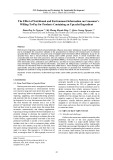
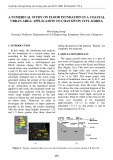
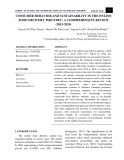
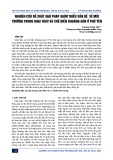
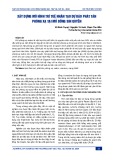

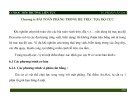
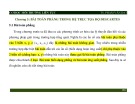






![Bài giảng Chế biến khoáng sản vô cơ [Mới nhất]](https://cdn.tailieu.vn/images/document/thumbnail/2025/20251025/thanhvan173002/135x160/21521761538638.jpg)
